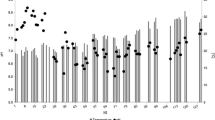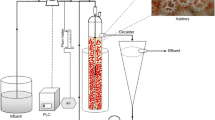Abstract
The deammonification process is a promising technology, while achieving stable performance is still a challenge for domestic sewage treatment. To investigate the stability of deammonification in the plug flow system, which can be updated from A/O or A/A/O bioreactor, a plug flow fixed biofilm reactor was started-up and fed with synthetic low-strength wastewater. As a result, average ammonium removal efficiency of 90.0 ± 10.0% and total nitrogen removal efficiency of 79.4 ± 9.3% were achieved, while the nitrate production ratio (∆Nitrate/∆Ammonium) was at superior levels (9.5 ± 3.4%). Candidatus Jettenia and Candidatus Brocadia were the anammox bacteria in this reactor, and Candidatus Jettenia was the predominant anammox bacteria. Anammox bacteria were dominated in three of the four sampling points except the first one. Relative abundance of NOB increased along the reactor. The result of the present work implied that the plug flow system was able to maintain stable deammonification process, and NOB was suppressed by higher residual ammonium concentration in the front of reactor while the suppression weakened along the reactor.






Similar content being viewed by others
References
Cao Y, van Loosdrecht MCM, Daigger GT (2017) Mainstream partial nitritation–anammox in municipal wastewater treatment: status, bottlenecks, and further studies. Appl Microbiol Biotechnol 101:1365–1383
DeSantis TZ, Hugenholtz P, Larsen N et al (2006) Greengenes, a chimera-checked 16S rRNA gene database and workbench compatible with ARB. Appl Environ Microbiol 72:5069–5072
Edgar RC (2013) UPARSE: highly accurate OTU sequences from microbial amplicon reads. Nat Methods 10:996–998
Fadrosh DW, Ma B, Gajer P, Sengamalay N, Ott S, Brotman RM, Ravel J (2014) An improved dual-indexing approach for multiplexed 16S rRNA gene sequencing on the IlluminaMiSeqplatform. Microbiome 2:6
Gilbert EM, Agrawal S, Brunner F, Schwartz T, Horn H, Lackner S (2014) Response of different Nitrospira species to anoxic periods depends on operational DO. Environ Sci Technol 48:2934–2941
Jin L, Zhang G, Tian H (2014) Current state of sewage treatment in China. Water Res 66:85–98
Kartal B, Kuenen JG, Van Loosdrecht MCM (2010) Sewage treatment with anammox. Science (80- ) 328:702–703
Lackner S, Gilbert EM, Vlaeminck SE, Joss A, Horn H, van Loosdrecht MCM (2014) Full-scale partial nitritation/anammox experiences - an application survey. Water Res 55:292–303
Laureni M, Falås P, Robin O, Wick A, Weissbrodt DG, Nielsen JL, Ternes TA, Morgenroth E, Joss A (2016) Mainstream partial nitritation and anammox: long-term process stability and effluent quallty at low temperatures. Water Res 101:628–639
Li X, Sun S, Badgley BD, Sung S, Zhang H, He Z (2016) Nitrogen removal by granular nitritation-anammox in an upflow membrane-aerated biofilm reactor. Water Res 94:23–31
Li J, Zhang L, Peng Y, Zhang Q (2017a) Effect of low COD/N ratios on stability of single-stage partial nitritation/anammox (SPN/A) process in a long-term operation. Bioresour Technol 244:192–197
Li X, Sun S, Yuan H, Badgley BD, He Z (2017b) Mainstream upflow nitritation-anammox system with hybrid anaerobic pretreatment: long-term performance and microbial community dynamics. Water Res 125:298–308. https://doi.org/10.1016/j.watres.2017.08.048
Liu Y, Liu QS (2006) Causes and control of filamentous growth in aerobic granular sludge sequencing batch reactors. Biotechnol Adv 24:115–127
Lotti T, Kleerebezem R, Hu Z et al (2015) Pilot-scale evaluation of anammox-based mainstream nitrogen removal from municipal wastewater. Environ Technol (United Kingdom) 36:1167–1177
Luo J, Chen H, Han X, Sun Y, Yuan Z, Guo J (2017) Microbial community structure and biodiversity of size-fractionated granules in a partial nitritation-anammox process. FEMS Microbiol Ecol 93. https://doi.org/10.1093/femsec/fix021
Ma B, Wang S, Cao S, Miao Y, Jia F, du R, Peng Y (2015) Biological nitrogen removal from sewage via anammox : recent advances. Bioresour Technol 200:981–990. https://doi.org/10.1016/j.biortech.2015.10.074
Ma B, Wang S, Cao S, Miao Y, Jia F, du R, Peng Y (2016) Biological nitrogen removal from sewage via anammox: recent advances. Bioresour Technol 200:981–990
Magoč T, Salzberg SL (2011) FLASH: fast length adjustment of short reads to improve genome assemblies. Bioinformatics 27:2957–2963
Miao Y, Zhang L, Li B, Zhang Q, Wang S, Peng Y (2017) Enhancing ammonium oxidizing bacteria activity was key to single-stage partial nitrification-anammox system treating low-strength sewage under intermittent aeration condition. Bioresour Technol 231:36–44
Pérez J, Lotti T, Kleerebezem R, Picioreanu C, van Loosdrecht MCM (2014) Outcompeting nitrite-oxidizing bacteria in single-stage nitrogen removal in sewage treatment plants: a model-based study. Water Res 66:208–218
Pinto AJ, Marcus DN, Ijaz Z (2016) Metagenomic Evidence for the presence of comammox Nitrospira-like bacteria in a drinking water system. Msphere 1:1–8
Poot V, Hoekstra M, Geleijnse MAA, van Loosdrecht MCM, Pérez J (2016) Effects of the residual ammonium concentration on NOB repression during partial nitritation with granular sludge. Water Res 106:518–530
Qiu S, Hu Y, Liu R, Sheng X, Chen L, Wu G, Hu H, Zhan X (2019) Start up of partial nitritation-anammox process using intermittently aerated sequencing batch reactor : performance and microbial community dynamics. Sci Total Environ 647:1188–1198
Siegrist H, Salzgeber D, Eugster J, Joss A (2008) Anammox brings WWTP closer to energy autarky due to increased biogas production and reduced aeration energy for N-removal. Water Sci Technol 57:383–388
Sliekers AO, Derwort N, Gomez JLC et al (2002) Completely autotrophic nitrogen removal over nitrite in one single reactor. Water Res 36:2475–2482
Soliman M, Eldyasti A (2018) Ammonia-oxidizing bacteria ( AOB ): opportunities and applications — a review. Springer, Netherlands
Vlaeminck SE, De Clippeleir H, Verstraete W (2012) Microbial resource management of one-stage partial nitritation/anammox. Microb Biotechnol 5:433–448
Wang X, Gao D (2018) The transformation from anammox granules to deammonification granules in micro-aerobic system by facilitating indigenous ammonia oxidizing bacteria. Bioresour Technol 250:439–448
Wang Q, Garrity GM, Tiedje JM, Cole JR (2007) Naïve Bayesian classifier for rapid assignment of rRNA sequences into the new bacterial taxonomy. Appl Environ Microbiol 73:5261–5267
Wang C, Liu S, Xu X, Zhang C, Wang D, Yang F (2018a) Achieving mainstream nitrogen removal through simultaneous partial nitrification, anammox and denitrification process in an integrated fixed film activated sludge reactor. Chemosphere 203:457–466
Wang X, Yan Y, Gao D (2018b) The threshold of influent ammonium concentration for nitrate over-accumulation in a one-stage deammonification system with granular sludge without aeration. Sci Total Environ 634:843–852
Xu G, Zhou Y, Yang Q, Lee ZMP, Gu J, Lay W, Cao Y, Liu Y (2015) The challenges of mainstream deammonification process for municipal used water treatment. Appl Microbiol Biotechnol 99:2485–2490
Yang Y, Zhang L, Cheng J, Zhang S, Li B, Peng Y (2017) Achieve efficient nitrogen removal from real sewage in a plug-flow integrated fixed-film activated sludge (IFAS) reactor via partial nitritation/anammox pathway. Bioresour Technol 239:294–301
Funding
This work was supported by the National Natural Science Foundation of China (No. 31870471, 31470543), the Heilongjiang Natural Science Foundation (No. C2017003), and Applied Technology Research and Development Project of Harbin (2016RAXXJ010).
Author information
Authors and Affiliations
Corresponding author
Additional information
Responsible editor: Bingcai Pan
Publisher’s note
Springer Nature remains neutral with regard to jurisdictional claims in published maps and institutional affiliations.
Rights and permissions
About this article
Cite this article
Peng, Z., Gao, D., Xiang, T. et al. Achieving stable and efficient single-stage deammonification using plug flow reactor. Environ Sci Pollut Res 26, 28031–28039 (2019). https://doi.org/10.1007/s11356-019-06015-y
Received:
Accepted:
Published:
Issue Date:
DOI: https://doi.org/10.1007/s11356-019-06015-y




